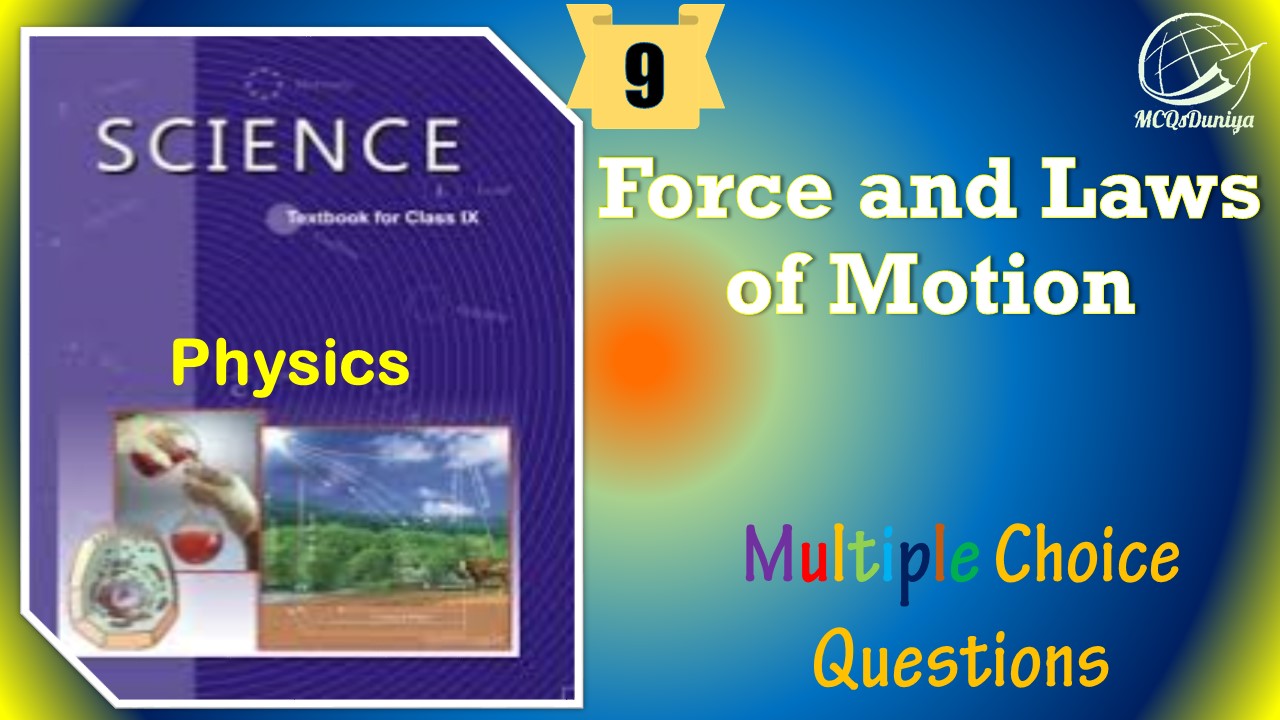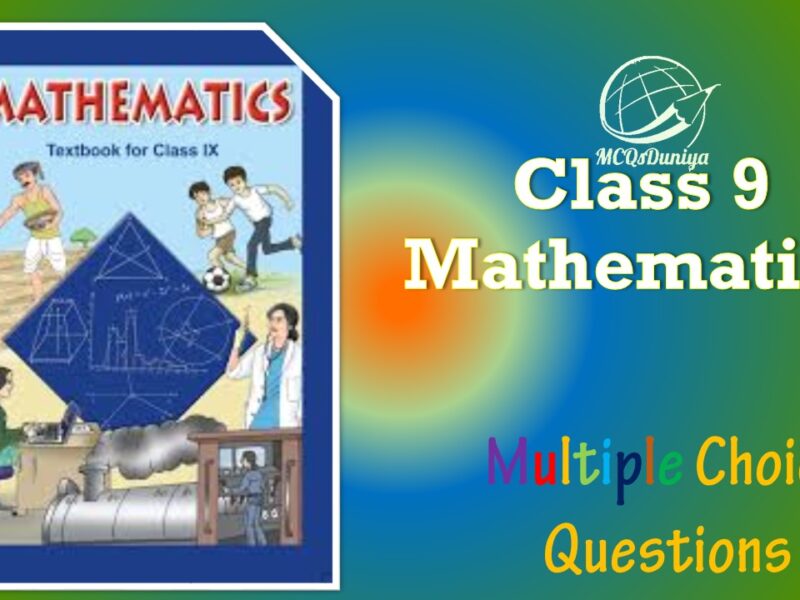Class 9 Science MCQ Force and Laws of Motion with Answers is Prepared Based on Latest Exam Pattern. Students can solve NCERT Class 9 Science MCQ Force and Laws of Motion with Answers to know their preparation level.
Students who are searching for NCERT Class 9 Science MCQ Force and Laws of Motion with Answers are compiled here to get good practice on all fundamentals. Know your preparation level on MCQ Questions for Class 9 Science MCQ Force and Laws of Motion with Answers. You can also verify your answers from the provided Class 9 Science MCQ Force and Laws of Motion with Answers. So, ace up your preparation with MCQ of Class 9 Science MCQ & NCERT Textbook solutions Examinations.
NCERT Class 9 Science MCQ Force and Laws of Motion with Answers
Question :Rocket works on the principle of conservation of:
(a) mass
(b) energy
(c) momentum
(d) velocity
Answer : (c) momentumShow Answer :
Question :Among the equal-sized stone and a football, the inertia will be higher of:
(a) football
(b) stone
(c) both
(d) none of them
Answer : (b) stoneShow Answer :
Question :A batsman hits a cricket ball which then rolls on the ground. After covering a short distance, the ball comes to rest. The ball slows to a stop because:
(a) the batsman did not hit the ball hard enough.
(b) velocity is proportional to the force exerted on the ball.
(c) there is a force on the ball opposing the motion.
(d) there is no unbalanced force on the ball so the ball would want to come to rest.
Answer : (c) there is a force on the ball opposing the motion.Show Answer :
Question :What is the momentum of an object of mass m, moving with a velocity v?
(a) (mv)2
(b) mv2
(c)
(d) mv
Answer : (d) mvShow Answer :
Question :Friction is:
(a) useful to us
(b) harmful to us
(c) both useful as well as harmful to us
(d) none of them.
Answer : (c) both useful as well as harmful to usShow Answer :
Question : Among the equal-sized stone and a football, the inertia will be higher of:
(a) football
(b) stone
(c) both
(d) none of them
Answer :(b) stoneShow Answer :
Question : A water tank filled upto 2/3 of its height is moving with a uniform speed. On sudden application of the brake, the water in the tank would
(a) Move backward
(b) Move forward
(c) Come to the rest
(d) Be unaffected
Answer :(b) Move forwardShow Answer :
Question : According to the third law of motion, action and reaction
(a) always act on the same body
(b) always act on different bodies in opposite directions
(c) have same magnitude and directions
(d) act on either body at normal to each other
Answer :(b) always act on different bodies in opposite directionsShow Answer :
Question : The inertia of an object tends to cause the object
(a) to increase its speed
(b) to decrease its speed
(c) to resist any change in the state of rest or of motion
(d) to decelerate due to friction
Answer :(c) to resist any change in the state of rest or of motionShow Answer :
Question : The inertia of an object tends to cause an object :
(a) to increase its speed
(b) to decrease its speed
(c) to resist a change in its state of motion
(d) to decelerate due to friction
Answer :(c) to resist a change in its state of motionShow Answer :
Question : Under which of the following conditions, Van der Waal’s gas approaches ideal behaviour ?
(a) Extremely low pressure
(b) High pressure
(c) Low product of PV
(d) Low temperature
Answer :(c) Low product of PVShow Answer :
Question : Friction is:
(a) useful to us
(b) harmful to us
(c) both useful as well as harmful to us
(d) none of them.
Answer :(c) both useful as well as harmful to usShow Answer :
Question : When a balloon held between the hands is pressed, its shape changes. This happens because:
(a) Balanced forces act on the balloon
(b) Unbalanced forces act on the balloon
(c) Frictional forces act on the balloon
(d) Gravitational force acts on the balloon
Answer :(a) Balanced forces act on the balloonShow Answer :
Question : Rocket works on the principle of conservation of
(a) mass
(b) energy
(c) momentum
(d) velocity
Answer :(c) momentumShow Answer :
Question : Quantitative expression of force is given by:
(a) Newton’s second law of motion.
(b) Newton’s third law of motion.
(c) Newton’s first law of motion.
(d) Newton’s law of gravitation.
Answer :(a) Newton’s second law of motion.Show Answer :
Question : A passenger in a moving train tosses a coin which falls behind him. This shows that the motion of train is
(a) accelerated
(b) uniform
(c) retarded
(d) along circular track
Answer :(a) acceleratedShow Answer :
Question : Which of the following gases has the lowest average speed at 25°C ?
(a) NH3
(b) O2
(c) CH4
(d) H2S
Answer :(d)Show Answer :
Question : The unit of measuring the momentum of a moving body is:
(a) m/s
(b) kg.m/s
(c) kg.m/s²
(d) N m²/kg²
Answer :(b) kg.m/sShow Answer :
Question : If the mass of a body is doubled and its velocity becomes half, then the linear momentum of the body will
(a) remain same
(b) become double
(c) become half
(d) become four times.
Answer :(a) remain sameShow Answer :
Question : The S.I. unit of force is
(a) Newton-metre
(b) Newton
(c) Newton per second
(d) Newton per square metre
Answer :(b) NewtonShow Answer :
Question : If we release a magnet held in our hand, it falls to the ground. The force which makes the magnet fall down is an example of :
(a) balanced force
(b) unbalanced force
(c) magnetic force
(d) muscular force
Answer :(b) unbalanced forceShow Answer :
Question : An ideal gas expands according to PV = constant. On expansion,the temperature of gas
(a) will rise
(b) will drop
(c) will remain constant
(d) cannot be determined because the external pressure is not known
Answer :(c) will remain constantShow Answer :
Question : A man is standing on a boat in still water. If he walks towards the shore, then the boat will
(a) move away from the shore
(b) move towards the shore
(c) remain stationary
(d) none of these
Answer :(a) move away from the shoreShow Answer :
Question : If the force acting on the body is zero. Its momentum is:
(a) Zero
(b) Constant
(c) Infinite
(d) None of the above
Answer :(b) ConstantShow Answer :
Question : When a rubber balloon held between the hands is pressed, its shape changes. This happens because :
(a) balanced forces act on the balloon
(b) unbalanced forces act on the balloon
(c) frictional forces act on the balloon
(d) gravitational forces act on the balloon
Answer :(a) balanced forces act on the balloonShow Answer :
Question : Which statement about real gases is true ?
(a) Forces of attraction and repulsion exist between gas particles as close range
(b) The behaviour of real gases can be exactly predicted usig the ideal gas law
(c) The volume of the gas particle is zero
(d) The mass of the gas particles is zero
Answer :(a) Forces of attraction and repulsion exist between gas particles as close rangeShow Answer :
Question : A ball is thrown vertically upward in a train moving with uniform velocity. The ball will
(a) fall behind the thrower
(b) fall ahead of the thrower
(c) return back to the thrower
(d) fall on the left of the thrower
Answer :(c) return back to the throwerShow Answer :
Question : What force can change the velocity of a body of mass 1kg from 20 m/s to 30m/s in 2 seconds?
(a) 10 N
(b) 15 N
(c) 5 N
(d) 25 N
Answer :(c) 5 NShow Answer :
Question : A real gas at a very high pressure occupies
(a) Less volume then that of an ideal gas under identical condition
(b) More volume than that of an ideal gas under identical conditions
(c) Same volume than that of an ideal gas under identical conditions
(d) Cannot be predicted
Answer :(b) More volume than that of an ideal gas under identical conditionsShow Answer :
Question : The masses of two bodies are in ratio 5 : 6 and their velocities are in ratio 1 : 2. Then their linear momentum will be in the ratio
(a) 5 : 6
(b) 1 : 2
(c) 12 : 5
(d) 5 : 12
Answer :(d) 5 : 12Show Answer :
Question : When a 12 N force acts on 3 kg mass for a second, the change in velocity is (in m/s)
(a) 36
(b) 4
(c) 2
(d) 18
Answer :(b) 4Show Answer :
Question : Temperature according to kinetic theory, is a measure of
(a) Average translational kinetic energy of gas molecules
(b) Intermolecular attraction
(c) Intermolecular distances
(d) Volume f gas
Answer :(a) Average translational kinetic energy of gas moleculesShow Answer :
Question : A force is defined as a
(a) Fall
(b) Pull
(c) Push or Pull
(d) Push
Answer :(c) Push or PullShow Answer :
Question : The acceleration of an object is
(a) inversely proportional to its mass
(b) directly proportional to the applied force
(c) resisted by inertia
(d) all of the above
Answer :(d) all of the aboveShow Answer :
Question : Change in momentum when a car weighing 700kg changes its speed from 100m/s to 200 m/s is:
(a) 14000 kg.m/s
(b) 10500000 kg.m/s
(c) 21000000 kg.m/s
(d) 70000 kg.m/s
Answer :(d) 70000 kg.m/sShow Answer :
Question :A body of mass 20 kg moves with an acceleration of 2ms–2. The rate of change of momentum in S.I. unit is –
(a) 40
(b) 10
(C) 4
(d) 1
Answer :AShow Answer :
Question :9.8 N is equal to-
(a) 1 kgf
(b) 1 kgwt
(C) A and B both
(d) Neither A nor B
Answer :CShow Answer :
Question :Newton used, ‘quantity of motion’ for-
(a) momentum
(b) force
(C) acceleration due to gravity
(d) none of these
Answer :AShow Answer :
Question : A cannon after firing recoils due to –
(a) conservation of energy
(b) backward thrust of gases produced
(C) Newton’s first law of motion
(d) Newton’s third law of motion
Answer 😀Show Answer :
Question : Newton’s first law of motion is –
(A) qualitative
(b) quantitative
(C) both qualitative and quantitative
(d) neither qualitative nor quantitative
Answer :AShow Answer :
Question :When a bus starts suddenly the passengers standing on it, lean backwards in the bus. This is an example of –
(a) Newton’s first law
(b) Newton’s second law
(C) Newton’s third law
(d) none of Newton’s law
Answer :AShow Answer :
Question : The law which defines force is –
(a) Newton’s third law
(b) Newton’s first law
(C) Newton’s second law
(d) none of these
Answer :Show Answer :
Question : An iron ball and aluminium ball has same mass:
(a) inertia of iron is greater than aluminium
(b) both the ball have same inertia
(C) inertia of iron is less than that of Aluminium
(d) none of these
Answer :BShow Answer :
Question : If A and B are two objects with masses 10 kgand 30 kg respectively then :
(a) A has more inertia than B
(b) B has more inertia than A
(C) A and B have the same inertia
(d) none of the two have inertia
Answer :BShow Answer :
Question : First law of motion defines-
(a) inertia
(b) force
(C) both inertia and force
(d) neither inertia nor force
Answer :CShow Answer :
Question :Momentum measures amount of ………… in a body-
(a) inertia
(b) motion
(C) velocity
(d) acceleration
Answer :BShow Answer :
Question : Force measures rate of change of ……….. a body
(a) mass
(b) inertia
(C) velocity
(d) momentum
Answer 😀Show Answer :
Question : Mass measures amount of …………..in a body-
(a) inertia
(B) motion
(C) velocity
(d) acceleration
Answer :AShow Answer :
Question : C.G.S. unit of force is –
(a) m/s
(b) s/m
(C) dyne
(d) Newton
Answer :CShow Answer :
Question : If a moving ball A collides with another moving ball B, then
(a) momentum of A = momentum of B
(b) (momentum A + momentum of B) before collision = (momentum A + momentum of B) after collision
(C) neither A nor B
(d) A or B both are possible
Answer :BShow Answer :
Question : When a bullet is fired from a gun. The gun recoils to –
(a) conserve mass
(b) conserve momentum
(C) conserve K.E
(d) none of these
Answer :BShow Answer :
Question : Momentum has same unit as –
(a) impulse
(b) torque
(C) moment of force
(d) couple
Answer :AShow Answer :
Question : When force of 1 N acts on mass of 1 kg, whichis able to move freely, the object moves with a/an –
(a) speed of 1 ms–1
(b) speed of 1 kms–1
(C) acceleration of 10 ms–2
(d) acceleration of 1 ms–2
Answer 😀Show Answer :
Question : The net force acting on a body of mass of 1 kg moving with a uniform velocity of 5 ms–1 is –
(a) 5 N
(b) 0.2 N
(C) 0 N
(d) None of these
Answer :CShow Answer :
Question : A body of mass M strikes against wall with a velocity v and rebounds with the same velocity. Its change in momentum is –
(a) zero
(b) Mv
(C) –Mv
(d) –2 Mv
Answer 😀Show Answer :
Question :Gram weight is a unit of-
(a) mass
(b) weight
(C) A and B both
(d) neither A nor B
Answer :BShow Answer :
Question :A body of mass 5 kg undergoes a change in speed from 20 m/s to 0.20 m/s. The momentum-
(a) increases by 99 kgm/s
(b) decreases by 99 kgm/s
(C) increases by 101 kgm/s
(d) decreases by 101 kgm/s
Answer :BShow Answer :
Question :Choose correct relation :
(a) a = F/m
(b)aF = m
(C) m = F × a
(d) none of these
Answer :AShow Answer :
Question :Inertia of rest is the property by virtue of which
the body is unable to change by itself:
(A) the state of rest only
(b) the state of uniform linear motion
(C) the direction of motion only
(d) the steady state of rest
Answer 😀Show Answer :
Question :A bullet in motion hits and gets embedded in a solid resting on a frictionless table. What is conserved ?
(a) Momentum and K.E.
(b) Momentum alone
(C) K.E. alone
(d) None of these
Answer :BShow Answer :
Question :Choose correct statement-
(a) Action and reaction forces act on same object.
(b) Action and reaction forces act on different objects.
(C) A and B both are possible.
(d) Neither A nor B is correct.
Answer :BShow Answer :
Question : The combined effect of mass and velocity is taken into account by a physical quantity called
(a) torque
(b) moment of force
(C) momentum
(d) all of them
Answer :CShow Answer :
Question : How many dynes are equal to 1 N ?
(a) 106
(b) 104
(C) 105
(d) 103
Answer :CShow Answer :
Question :A bullet of mass 0.01 kg is fired from a gun weighing 5.0 kg. If the initial speed of the bullet is 250 m/s, calculate the speed with which the gun recoils-
(a) – 0.50 m/s
(b) – 0.25 m/s
(C) + 0.05 m/s
(d) + 0.25 m/s
Answer :AShow Answer :
Question :A man is standing on a boat in still water. If he walks towards the shore the boat will –
(a) move away from the shore
(b) remain stationary
(C) move towards the shore
(d) sink
Answer :AShow Answer :
Fill in the Blanks.
Question :The SI unit of momentum is _________.
Answer : kgms-1Show Answer :
Question :The natural tendency of objects to resist a change in their state of rest or of uniform motion is called ______
Answer : inertiaShow Answer :
Question :To every action, there is an ______ and opposite reaction.
Answer : equalShow Answer :
Question :The resultant force of balanced forces is ________
Answer : zeroShow Answer :
Question :The force can change the motion, direction, or _______ of an object.
Answer : shapeShow Answer :
Question :The value of inertia depends on the _______ of an object.
Answer : massShow Answer :
Question :The rate of change of momentum of an object is ______ to the applied unbalanced force in the direction of the force.
Answer : proportionalShow Answer :
True/False.
Question :In 1586, Galileo Galilei wrote his first scientific book ‘The Little Balance’.
Answer : TrueShow Answer :
Question :In practical situations, it is difficult to achieve a zero balanced force.
Answer : FalseShow Answer :
Question :Force is a scalar quantity.
Answer : FalseShow Answer :
Question :The mass of an object is a measure of its inertia.
Answer : TrueShow Answer :
Question :In an isolated system, the total momentum remains conserved.
Answer : TrueShow Answer :
Answer in one Word/Sentence.
Question :Write the unit of pressure.
Answer : Nm-1 or pascalShow Answer :
Question :A body is moving with constant velocity, then what will be the acceleration of that body?
Answer : Zero (0)Show Answer :
Question :Write the S.I unit of force.
Answer : NewtonShow Answer :
Question :On what factor the inertia of an object depends?
Answer : On massShow Answer :
Question :Express the second law of motion of newton in the context of the equation of momentum.
Answer : Force = Show Answer :




